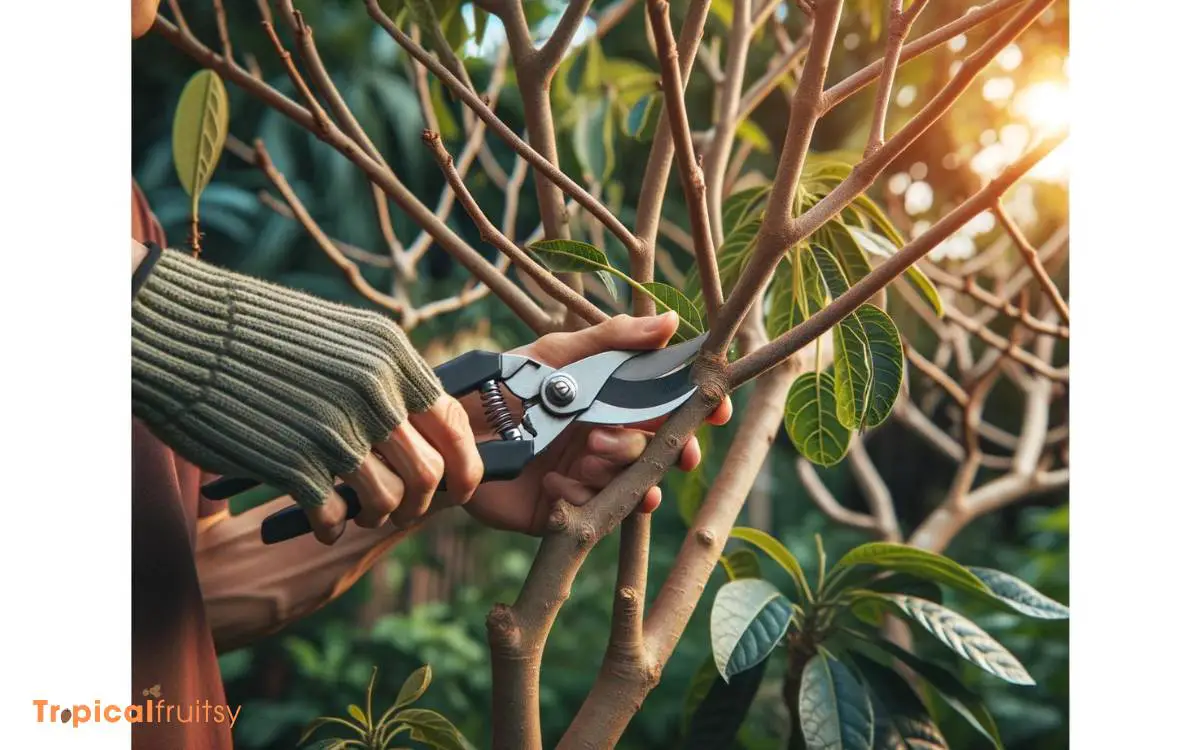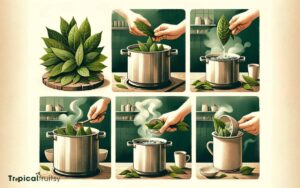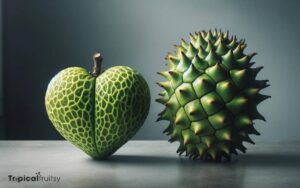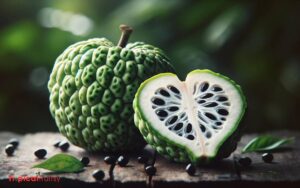How to Prune Cherimoya Tree
To properly prune a cherimoya tree, ensure you have sharp tools and prune during the dormant period to promote healthy growth and fruit production.
Start by removing dead or diseased branches, thin out crowded areas, and shape the tree to allow sunlight and air to reach the inner branches. Prune carefully to avoid over-pruning, which can stress the tree.
Pruning a cherimoya tree is essential to maintain its health and enhance fruit production.
The process involves:
Effective cherimoya tree pruning ensures a bountiful harvest and a vibrant, healthy tree.

Key Takeaway
Understanding Cherimoya Pruning
Pruning a cherimoya tree is essential for promoting healthy growth and maximizing fruit production.
Gardeners must approach this task with knowledge and precision, understanding that the timing, technique, and frequency of pruning can significantly impact the tree’s health and yield.
It’s best to prune during dormancy, typically in late winter or early spring, to avoid stressing the tree during its active growth phase.
Strategic removal of certain branches enhances sunlight penetration and air circulation, which are critical for the development of high-quality fruit. It also helps manage the tree’s size and shape, making it easier to harvest the cherimoyas.
Pruning isn’t just about cutting; it’s about thoughtful selection to foster robust branches that can support the weight of the fruit.
Necessary Pruning Tools
Equipping oneself with the right pruning tools is essential for the successful maintenance of a cherimoya tree.
Sharp, clean shears ensure precise cuts that promote healthy growth, while tool cleanliness prevents the spread of disease.
Additionally, tools with ergonomic handles offer comfort and reduce strain during the pruning process.
Selecting Proper Shears
Selecting the right shears is crucial for effectively pruning a cherimoya tree. Gardeners must choose tools that are sharp, comfortable to hold, and suitable for the size of the branches they’ll be cutting.
Hand pruners, also known as secateurs, are ideal for most cherimoya pruning tasks, as they can easily handle branches up to 3/4 inches in diameter.
For slightly larger limbs, up to about 1.5 inches thick, loppers provide the necessary leverage. When dealing with even bigger branches, a pruning saw becomes essential.
It’s important to ensure that the blades of all pruning tools are made of high-quality steel, which maintains sharpness and makes clean cuts, thus promoting swift healing of the pruned areas.
Maintaining Tool Cleanliness
Keeping your pruning tools clean not only ensures their longevity but also helps prevent the spread of disease among your cherimoya trees. Regular cleaning and disinfection are imperative after each use.
Here’s a simple table depicting the cleaning process:
| Step | Tool | Action |
|---|---|---|
| 1 | Pruning Shears | Remove sap and debris with a cloth soaked in soapy water |
| 2 | Disinfectant | Spray or dip tools in a solution of bleach or alcohol |
| 3 | Lubricant | Apply oil to moving parts to prevent rust |
| 4 | Storage | Keep in a dry, clean place to avoid contamination |
This routine ensures your tools remain in top condition, ready for the next pruning season. As you maintain tool cleanliness, consider the comfort of their use; ergonomic handle designs can significantly reduce hand strain.
Ergonomic Handle Designs
Comfort in pruning is essential, and ergonomic handle designs on tools can significantly ease the task. These specially crafted handles fit the natural contour of the gardener’s hand, reducing fatigue and the risk of repetitive strain injuries.
When selecting pruning tools for a cherimoya tree, it’s important to look for features such as soft grips that absorb shock and non-slip coatings that ensure stability during use.
Quality ergonomic pruners often have angled blades that promote a natural hand position, preventing awkward wrist bending.
They’re typically made with lightweight materials that contribute to overall comfort without sacrificing strength or durability.
With the right ergonomic tools in hand, gardeners can maintain their cherimoya trees with greater efficiency and less discomfort.
This sets the stage for the next important consideration: identifying the optimal pruning season.
Optimal Pruning Season
When should one prune a cherimoya tree to ensure healthy growth and optimal fruit production? The optimal pruning season is after the tree has finished fruiting, generally in late winter or early spring.
This timing allows gardeners to shape the tree without risking damage to the blossoms or young fruit. Pruning during this period encourages vigorous growth and aids in disease prevention.
Late winter’s crisp air and bare branches offer clear visibility for precise cuts. Early spring’s mild weather supports rapid healing of pruned areas.
Dormant season pruning minimizes sap loss, protecting the tree’s vitality. Post-harvest timing prevents unnecessary removal of fruiting wood.
Pruning outside this optimal season can lead to reduced yields and increased susceptibility to pests and diseases.
Pruning Techniques Explained
To properly prune a cherimoya tree, one must employ several key techniques that ensure healthy tree structure and abundant fruit production. These methods are vital for guiding the tree’s growth and maximizing yield.
| Technique | Purpose | Timing |
|---|---|---|
| Thinning | Reduces crowding, improves light penetration | Early spring |
| Heading Back | Encourages bushier growth, stimulates new shoots | Post-harvest |
| Selective Cutting | Removes dead or diseased branches, shapes tree | As needed |
| Sucker Removal | Eliminates growth from the base, focuses energy | Throughout growing season |
| Tip Pruning | Promotes fruiting spurs, maintains size | Mid to late summer |
Each cut should be made with precision, at a 45-degree angle, just above a bud facing the outside of the canopy. This encourages outward growth. Now, let’s delve into the important aftercare for pruned trees.
Aftercare for Pruned Trees
Once the cherimoya tree is pruned, it’s crucial to adjust the watering schedule to support recovery and growth.
Proper aftercare includes implementing disease prevention strategies to safeguard the fresh cuts from infection.
These steps ensure the tree remains healthy and can maximize fruit production in the following season.
Watering Schedule Adjustments
After pruning your cherimoya tree, it’s crucial to adjust its watering schedule to support recovery and new growth. The tree will need a consistent supply of moisture to heal the cuts and encourage the development of fresh foliage.
Here’s how to provide optimal hydration:
- Increase Frequency: Temporarily water more often to maintain damp soil without waterlogging.
- Monitor Soil Moisture: Check the soil’s moisture level regularly; it should be moist, not soggy.
- Morning Watering: Aim to water early in the day to reduce evaporation and give the tree time to absorb moisture.
- Reduce Water as New Growth Appears: Once the tree shows signs of new growth, gradually return to the normal watering schedule.
Applying these steps will ensure your cherimoya tree remains healthy and thrives after pruning.
Disease Prevention Measures
Pruning a cherimoya tree creates open wounds that can be vulnerable to infections, so it’s essential to apply disease prevention measures to protect the tree’s health.
After pruning, it’s advisable to treat the cuts with a suitable fungicidal wound dressing. This acts as a barrier against pathogens that could cause decay or disease.
It’s also critical to sanitize pruning tools before and after use to prevent the spread of disease from one plant to another. Disinfectant solutions or alcohol wipes are effective for this purpose.
Additionally, maintaining a clean environment around the cherimoya tree is vital. Remove any fallen debris and pruned material promptly, as these can harbor pests and diseases.
Ensuring good air circulation through proper spacing and pruning technique will further minimize disease risk.
Common Pruning Mistakes
While attempting to maintain their cherimoya trees, many gardeners inadvertently commit errors that can hinder the tree’s growth and fruit production. These common mistakes can be avoided with proper knowledge and technique.
Here are some typical errors:
- Over-pruning, which can shock the tree and reduce its yield
- Cutting too close to the main stem, risking disease and damage
- Pruning during the wrong season, potentially exposing the tree to harsh weather
- Neglecting to sanitize tools, spreading pathogens between plants
Understanding these pitfalls is crucial for gardeners who wish to optimize their cherimoya tree’s health and fruit production.
By avoiding these mistakes, they ensure a thriving tree that continues to produce delicious cherimoyas for seasons to come.
Conclusion
Pruning a cherimoya tree doesn’t have to be daunting. With the right tools and techniques, you can encourage healthy growth and bountiful fruit production.
Remember to prune during the optimal season and provide proper aftercare to keep your tree thriving.
Have you avoided common mistakes and set your tree up for success? By following these guidelines, you’re ensuring a stronger, more productive cherimoya for seasons to come.






